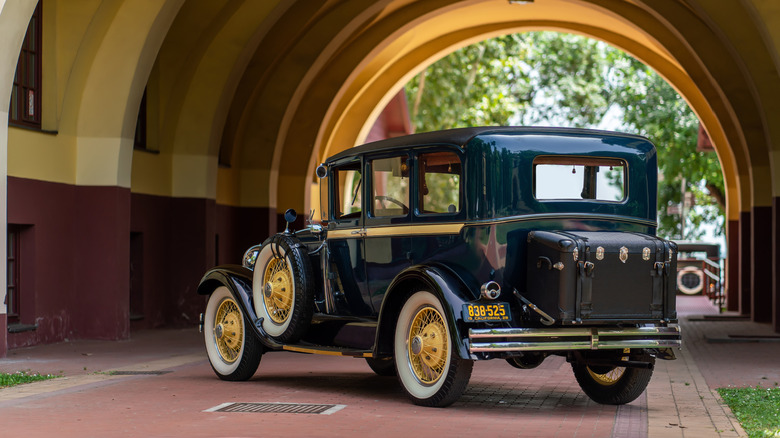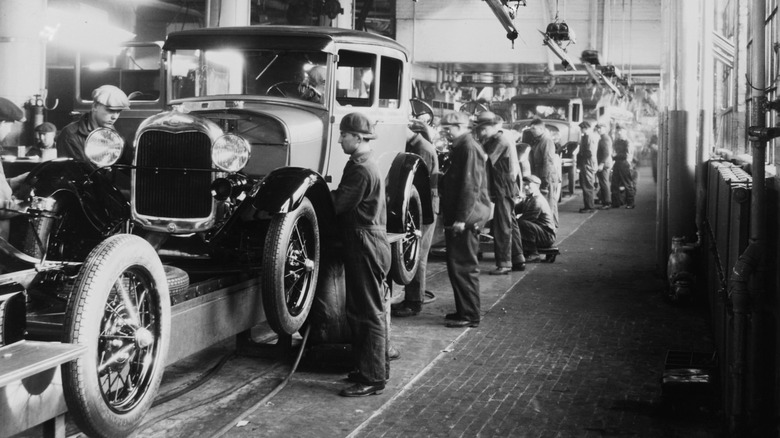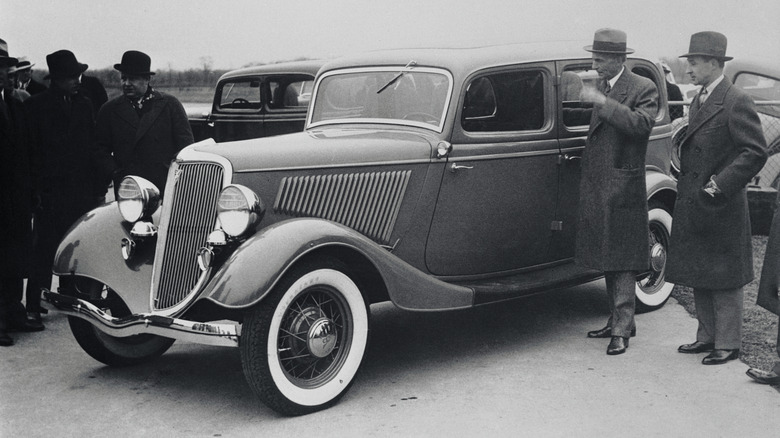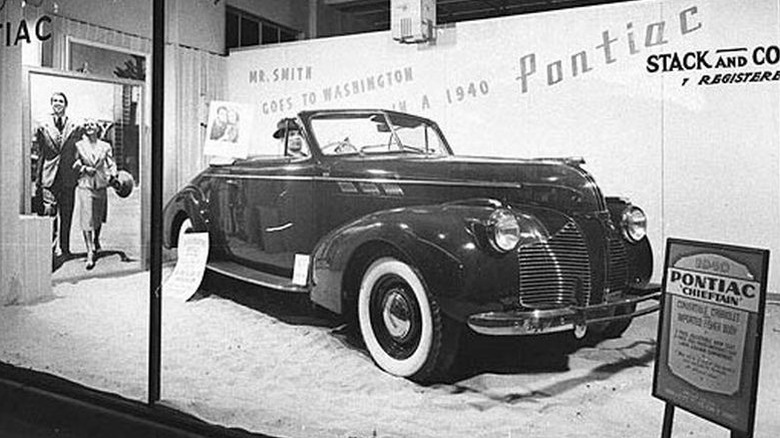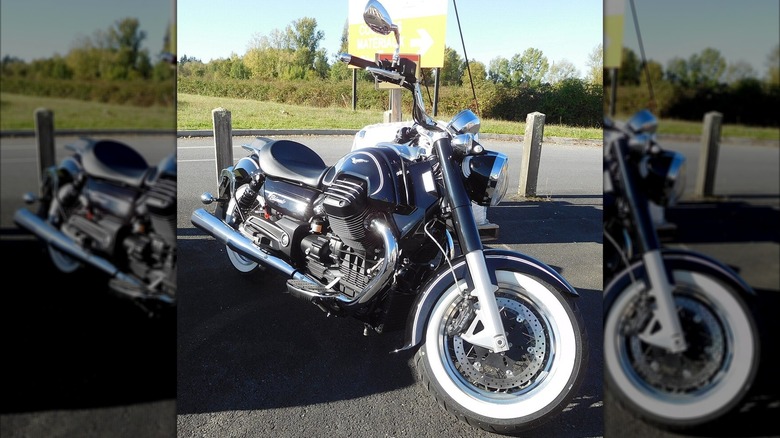What Happened To Whitewall Tires?
In Billy Joel's chart-topping 1980 song "It's Still Rock And Roll To Me," he sings, "What's the matter with the car I'm driving? Can't you tell that it's out of style? Should I get a set of whitewall tires?" For many, whitewall tires had their heyday in the 1950s, which might lead some to think their origins were part of the same cultural car movement that also gave us fuzzy dice to hang from rearview mirrors and the dancing hula girl to stick on dashboards. The reality is whitewall tires were around much earlier than the 1950s, and their history is not as straightforward as one might think.
Believe it or not,
. In fact, the first ones were an off-white color that had a milky, almost semi-translucent ivory appearance because that's just how natural untreated rubber looked. However, these early tires didn't have enough grip, so a white powder called zinc oxide was added, which significantly improved their effectiveness. It also made them bright white.
Credit is usually given to B.F. Goodrich for making the black tire we know today (in 1910) by adding a powdery byproduct known as carbon black (left over when elemental carbon is burned) that not only strengthened the tire but made it turn black. However, Sidney Charles Mote used it at the India Rubber Company in London six years earlier (1904). Even back then, it was a "generally known" process that was very likely invented and reinvented by many people separately from each other because it was never patented.
Whitewalls were a pricey premium product
Tires have changed significantly since their creation, and the addition of carbon black was one of those pivotal changes and a key to B.F. Goodrich's success. They were one of the first companies to commercialize these new tires, and most new cars that rolled out of the manufacturing plants did so on a set of black tires. Photos from the early years of automobiles show that most have black tires, mainly because white ones didn't last as long.
And here's where facts about whitewalls careen off the road into a ditch because there isn't clear-cut evidence about precisely what happens next. Some sources claim that whitewalls were created as a "cost-cutting measure" because adding this new carbon black compound also added cost. Or did it? Tom Halter at Curbside Classics did an in-depth deep dive regarding whitewall tires and states that since carbon black is created by simply burning coal (which naturally turns into soot), it was easily made in large amounts at little to no cost at all.
Some sources claim companies tried to cut costs by only adding carbon black to the tread, which left the natural sidewalls white. Halter says if there was any cost increase, it was because they were adding additional pieces of rubber to the tire. An ad from 1922 shows B.F. Goodrich Silvertown whitewall tires costing as much as $62 per tire, proving they were likely always considered "a premium product," and whatever cost was associated was passed on to the consumer via "opportunistic pricing."
Black or white? Clean or dirty?
Whatever the case, it appears whitewall tires were made entirely by accident and had nothing to do with how they looked or if they were aesthetically pleasing or not ... at least not at first. Once these new, longer-lasting, lower-maintenance black tires, that were also vulcanized and/or corded, topics for another time, became a better option than the inferior white tires, it was hard to convince drivers otherwise. It took time for consumers to become convinced that there should be any white on the tires at all.
By the late '20s, whitewalls were considered a stylish upgrade best suited for luxury cars like Duesenberg and LaSalle (a companion brand to GM's premier Cadillac), who heavily advertised them as a selling point for their vehicles. These high-end autos were usually driven by chauffeurs whose job it was to keep the car (and its white-walled tires) clean. They certainly weren't considered beneficial on vehicles driven by blue-collar workers who had neither the time nor money to maintain such fancy tires.
Yet, here's where a new paradigm shift in thinking may have begun. Ed's Auto Reviews theorizes that since black tires were easy to clean and maintain and whitewalls weren't, the time and effort to keep them clean became something to brag about. Then, Ford began to offer whitewall tires as an option on new car models starting in 1934 for as little as $11.25, making them affordable to the masses who had previously thought the classy upgrade was out of their price range.
World War II caused whitewalls to vanish ... temporarily
The popularity of whitewalls continued to rise throughout the 30s as more and more people bought into the affordability of perceived classiness. Then, World War II hit Europe in 1939. According to Tom Halter at Curbside Classics, nearly every manufacturer's advertisements in 1940, including Ford, Plymouth, Chevrolet, Pontiac, and Oldsmobile, showed cars with all-black tires instead of whitewalls. But, luxury brands like Buick, Cadillac, and (whatever happened to) Packard maintained the status quo on whitewall advertising until the United States joined the war at the end of 1941.
Although the war ended in 1945, it took a few more years before the luster of luxury once again washed across the land, and in 1948, automakers started advertising their cars with whitewall tires. By the following year, nearly every car maker in the U.S. was back to advertising almost all makes and models clad with whitewall tires. This coincided with the general post-war economic boom across the U.S. People who had to ration during the war years were ready to spend money, which in turn led to the Golden Age of Capitalism.
Around the same time, another shiny (literally) new accouterment started appearing that would help take whitewalls and automobile glamour to all-new heights during the 1950s. Advancements in the manufacturing of chrome plating allowed for mass production on such a scale that virtually every automaker soon began offering a cornucopia of chromed plated options — because nothing screamed luxury and success more than gleaming mirror-like metal wrapping your ride.
If you wait, a fad will always come back into style
During the hot rod craze of the 1950s, you had those meant for racing and those displayed at car shows. Racers usually sported purpose-built black racing tires, but the highly customized show rods almost always wore a lot of chrome, an eye-catching paint job ... and wide whitewall tires. Today, the 50s is regarded as the golden age of automobiles (even though people living through it at the time didn't see it that way) because it not only coincided with prosperity in post-war America but was a time when Americans became truly obsessed with their cars.
New whitewalls were once so well regarded they came wrapped in paper to keep the gleaming white sidewalls pristine. But as the 50s closed, tire styles changed, and the once-wide whitewalls were shrunk to a mere 2.5-inch stripe. Another change happened in 1962 when most manufacturers went even thinner with a 1-inch stripe until, eventually, it was nothing more than a thin line and a far cry from a "wall" of white.
Pontiac abandoned whitewalls in their brochures in 1989; Ford did so in 1991, and Chrysler in 1994. Cadillac, Chevrolet, and Buick followed in 1996. Finally, Lincoln left whitewalls by the side of the road after its 2010 model year Town Car (which was discontinued a year later). Collectors, enthusiasts, and even motorcyclists who want a distinctive or period-accurate look have all kept the need for replacement aftermarket whitewall tires alive since. And, by some accounts, they're as popular as ever.
